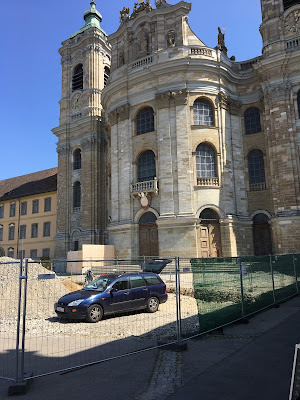
In September 1969 while on a caravan trip in South Germany I first saw Weingarten. It was for once not a case of searching for a known place, but of stumbling across something huge and incomprehensible. The next time I came was twenty years later in August 1989 on my own. I was staying in central Ulm and wanted to get to Weingarten for 10.00 Sunday Mass. The train toward Weingarten was good but the minutes ticked by dangerously. How would I do it? Started walking then reached my goal using a huge Mercedes taxi. It drew up just near the door above. I had missed the start but most of the Mass was to come. The organ was magnificent but the building made a deep impression on me. So did the cheese spatzle I had in a nearby restaurant..I vowed to return.
This time in August 2019 it was by car and we parked in a hillside multistorey. Issuing from a tunnel near the top we quickly saw that the west front was a building site.(see above) It was quite hard to find the alternative entrance. Once inside I tried to find the seat where I had experienced the Mass on my previous visit. (see below)
This Benedictine foundation from 1056 became an Imperial Abbey (ecclesiastical territory subject only to the Holy Roman Emperor) in 1274 and the Abbot ruled over 118 square miles from the Allgau to Lake Constance - forests and vineyards leading it to become one of the richest monasteries in Southern Germany. The 12th century church was demolished and replaced 1715-24 by this huge Baroque building we now see. It is known sometimes as the Swabian St Peter's and a length of 102 metres is exactly half the length of its Italian cousin.. It is the largest Baroque church in Germany as well as being the second largest overall in Germany. The monastery was dissolved in 1803 and after various uses part of the abbey buildings have been used since 2014 to house refugees.
The church was designed and built by a number of architects :Caspar Moosbrugger Franz Beer and Donato Giuseppe Frisoni. Monumental ,massive, richly decorated yet still the architecture is dominant. (No comparison with Mexican Baroque where many churches are simple boxes covered in rich Churriguesque decoration).It is a huge 3 bay wall pillar nave with shallow absidal transepts, 2 bay choir with absidal sanctuary. Comparisons can be made with the Kollegiate church in Salzburg and Einsiedeln Abbey in Switzerland. The central dome is very successful and can be compared with the Theatiner Church in Munich and Melk Abbey in Austria.
The wall pillars are pierced at ground land gallery levels and the concave balconies above almost make the pillars look detached.(see below)
 |
| View into the choir with alrat of the Holy Blood |
 |
| Reception of the Holy Blood reliquary |
 |
| St Benedict in heavenly glory surrounded by saints and nobles |
The organ has over 6600 pipes, on 4 manuals and pedal. The six windows behind were not be covered up and so Gabler came up with the unique open feeling case design. It is a masterpiece - to look and to hear.[]
 |
 |
| The choir grille is by Paul Nortz (c1730) The high altar by Donato Giuseppe Frisone (1719-23)Painting is Deposition from the Cross by Carlo Carlone |
The choir stalls are by the 24 year old Josef Anton Feuchtmeyer (1720)
The dome has a fresco by CD Asam of the Church triumphant ; angels adoring the Trinity.









No comments:
Post a Comment